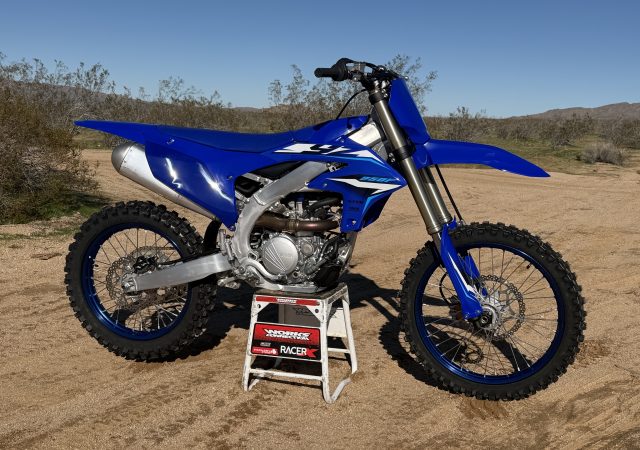
For this edition of Classic Steel, we are going to take a look back at Yamaha’s all-new 2003 YZ450F.
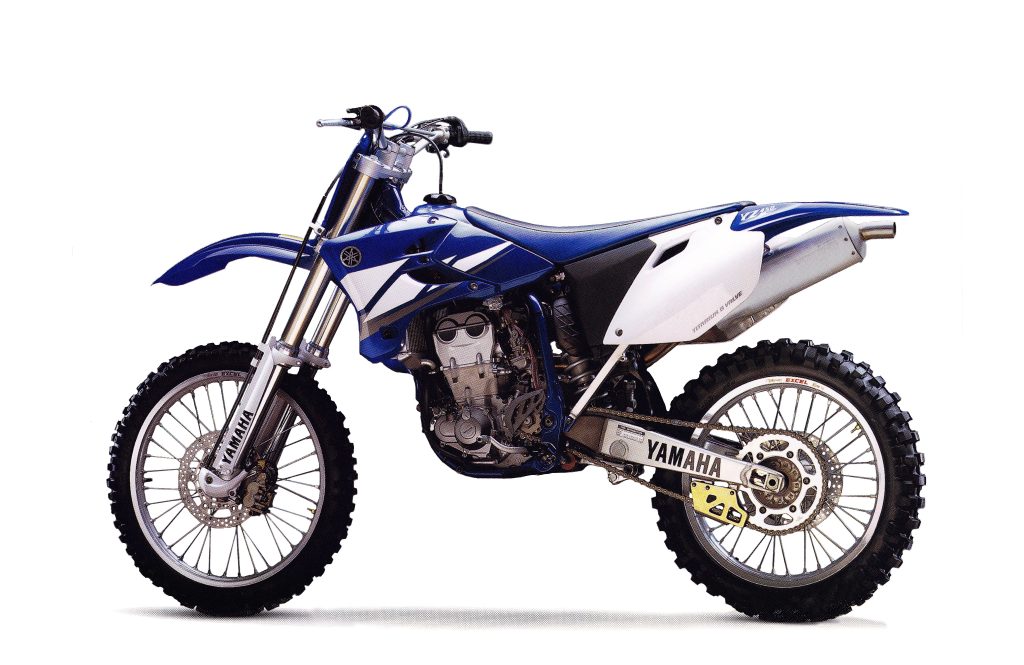 In 2003, Yamaha debuted its first major redesign of the machine that shocked the motocross world in 1998. Lighter, faster, and more hard-edged than before, the all-new YZ450F was bred to win. Photo Credit: Yamaha
In 2003, Yamaha debuted its first major redesign of the machine that shocked the motocross world in 1998. Lighter, faster, and more hard-edged than before, the all-new YZ450F was bred to win. Photo Credit: Yamaha
In 1998, Yamaha kicked off the modern four-stroke revolution with the introduction of its ground-breaking YZ400F. Before the YZ400F, most motocross four-strokes offered slow-building powerbands that chugged and churned rather than barked and blasted. This style of power was excellent off-road, but not always ideal for the cut-and-thrust world of motocross. Mega thumpers like the ATK605, Husqvarna TC610, KTM 620, and Husaberg FC501 had their fans, but the majority of mainstream motocross racers found them to be more of a curiosity than a viable racing alternative.
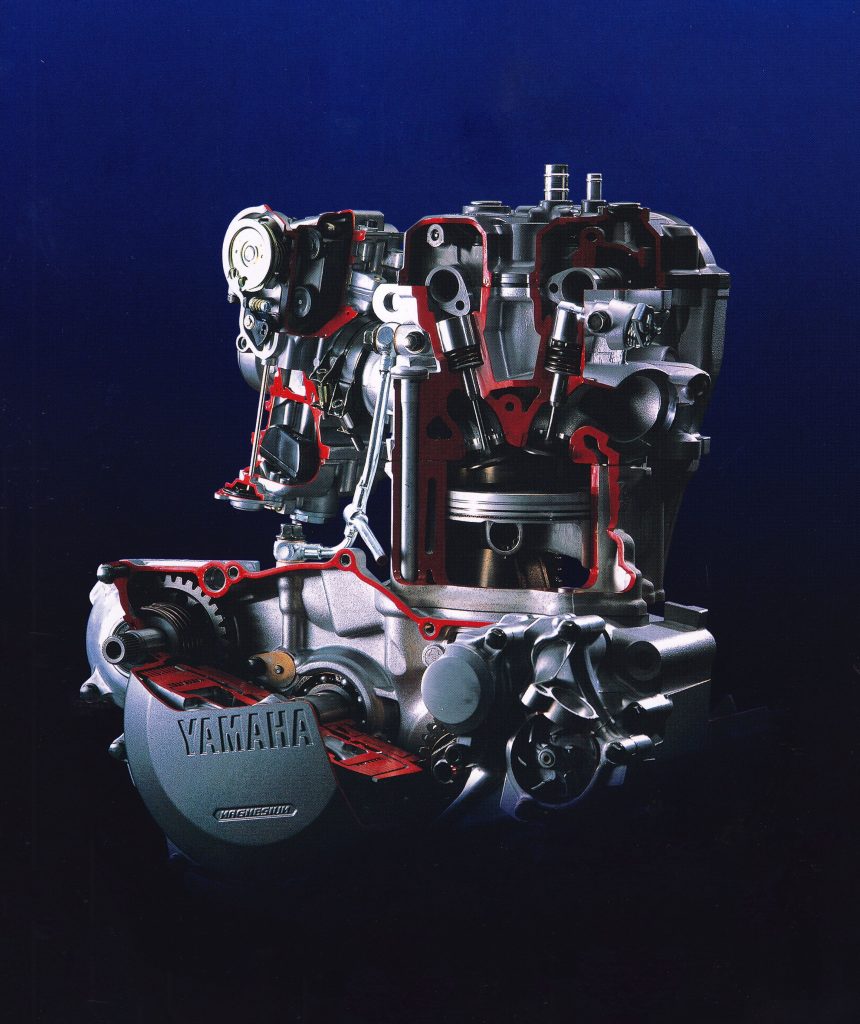 The all-new 449cc motor on the YZ450F featured a more compact head, longer stroke, and dozens of changes aimed at shedding weight and boosting power. Photo Credit: Yamaha
The all-new 449cc motor on the YZ450F featured a more compact head, longer stroke, and dozens of changes aimed at shedding weight and boosting power. Photo Credit: Yamaha
Where the YZ400F broke new ground was in the design of its motor. By using a short-stroke and five-valve Genesis head from their road racing department, Yamaha was able to imbue the YZ400F with a quick-revving style of power that was completely unlike any other four-stroke motocrosser before it. With its ultra-smooth powerband, the YZ-F could find traction on nearly any surface while still offering enough power to outmuscle most of its two-stroke competitors. It was both remarkably fast and incredibly easy to ride and consumers snapped them up in droves.
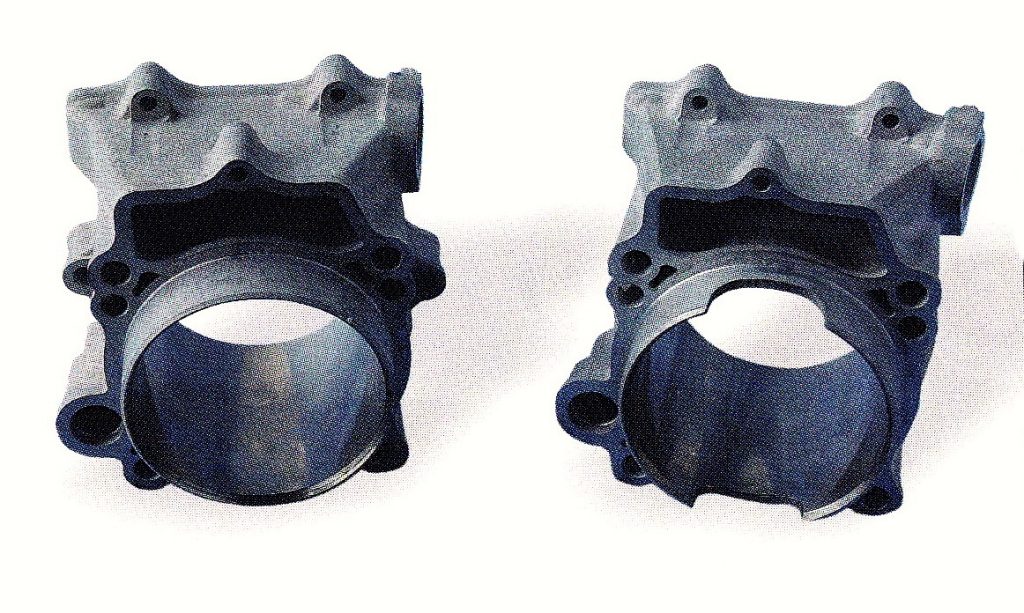 An all-new cylinder for 2003 (right) adopted tricks used on Tim Ferry’s factory bike by adding cutouts to the lower skirt to improve crankcase pressure venting and increase responsiveness. Photo Credit: Yamaha
An all-new cylinder for 2003 (right) adopted tricks used on Tim Ferry’s factory bike by adding cutouts to the lower skirt to improve crankcase pressure venting and increase responsiveness. Photo Credit: Yamaha
While the original YZ400F proved an incredible commercial success, it was not without its share of peccadillos. The YZ-F’s weight remained substantially higher than its two-stroke competitors and that heavy feel never went away on the track. Overall handling was excellent, but if the big blue machine got out of shape it was a handful to reign back in. Starting the 400F was an adventure on its own with the machine requiring an elaborate ritual that was difficult to master and nearly impossible to execute in the heat of battle. Grabbing a handful of throttle was often rewarded with a hiccup from the motor and having the machine hesitate at an inopportune moment was a surefire recipe for trouble. Technical jump combinations that were easy to execute on an ultra-responsive two-stroke were often more like playing Russian Roulette on the sometimes-unpredictable YZ-F. Compared to every other four-stroke before it, the YZ400F was a revelation, but that did not stop it from suffering from many of the same drawbacks as its valve-and-cam predecessors.
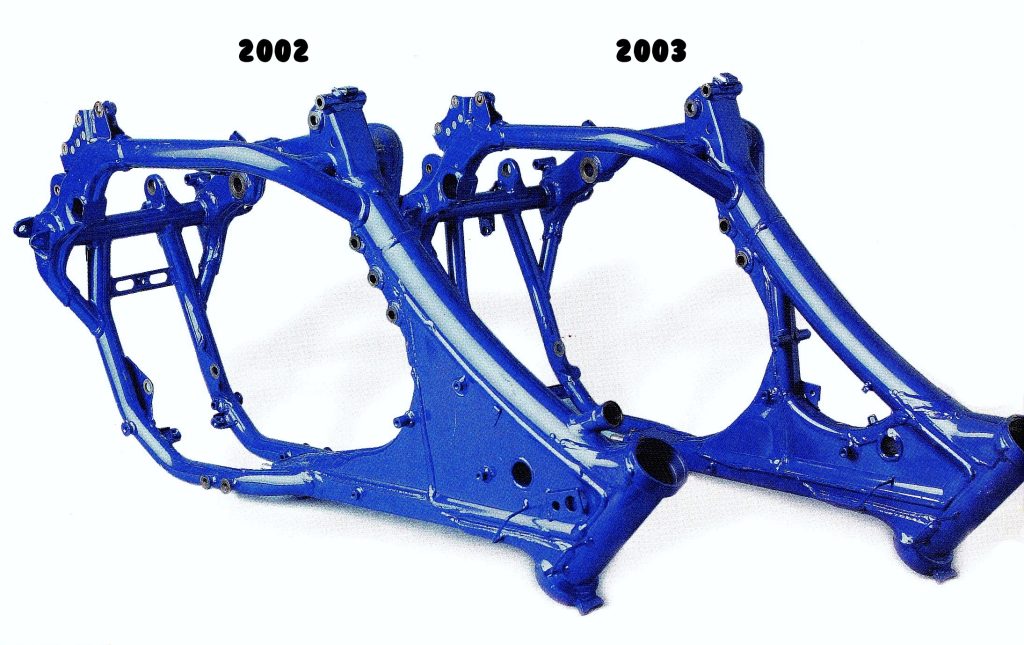 A new frame for 2003 shed three pounds of weight over the 2002. Photo Credit: Yamaha
A new frame for 2003 shed three pounds of weight over the 2002. Photo Credit: Yamaha
In 2000, Yamaha introduced the first major update to their YZ-F platform in the form of the all-new YZ426F. Visually almost identical to the original YZ400F, the new 426 featured an all-new motor, revamped frame, updated suspension, and two-pound weight savings over 1999. The new motor displaced an additional 26cc and offered a completely new personality on the track. Whereas the original YZ400F pumped out a smooth and electric style of power that pulled from the bottom to the top without any hit or drama, the new YZ426F barked out of the hole and snarled through the middle. The new motor was much more like a traditional big bore four-stroke in its personality and a significant departure from the rev-happy 400F. At the time, most racers seemed to like this change and the YZ-F continued its domination of the big-bore four-stroke wars.
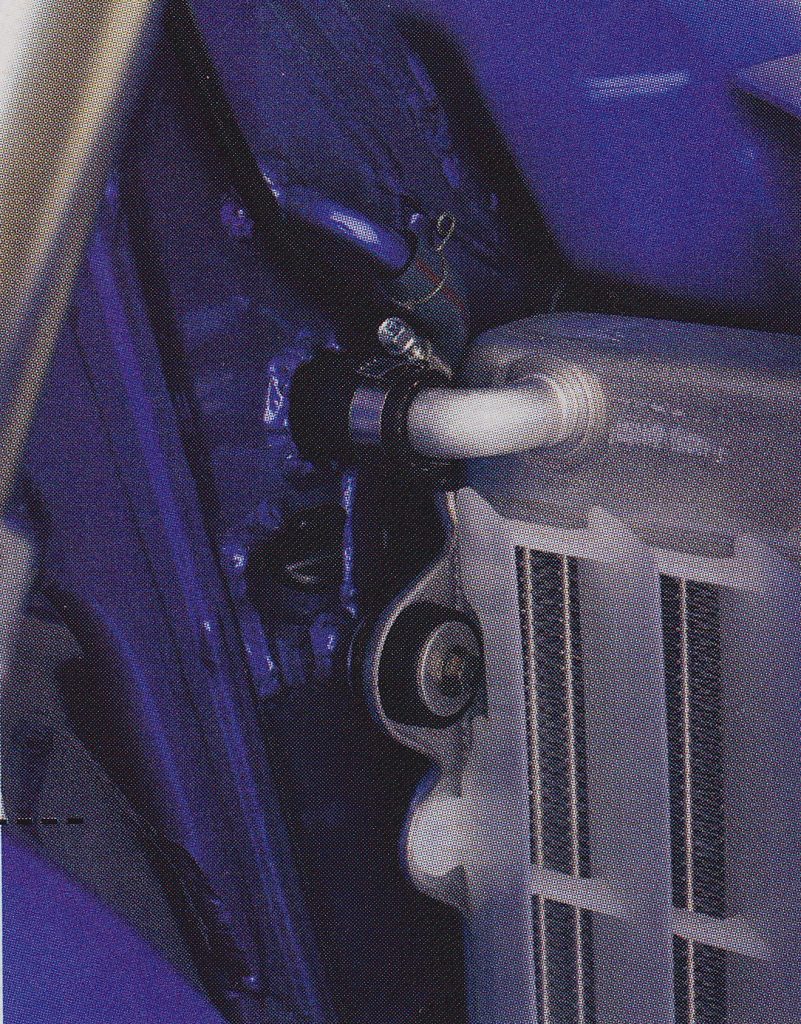 For 2003, Yamaha shrunk the size of the external oil tank by 500cc and repositioned it lower on the frame to improve weight distribution. Photo Credit: Yamaha
For 2003, Yamaha shrunk the size of the external oil tank by 500cc and repositioned it lower on the frame to improve weight distribution. Photo Credit: Yamaha
As the 2000s started, however, the YZ-F began to feel a bit more pressure from its competitors. The all-new Cannondale MX400 turned out to largely be vaporware, but the KTM 520SX proved its mettle with a rompin’ stompin’ powerband and a 15-pound weight advantage over the YZ426F. Neither machine was capable of unseating the Yamaha as the king of motocross thumpers, but the class was heating up.
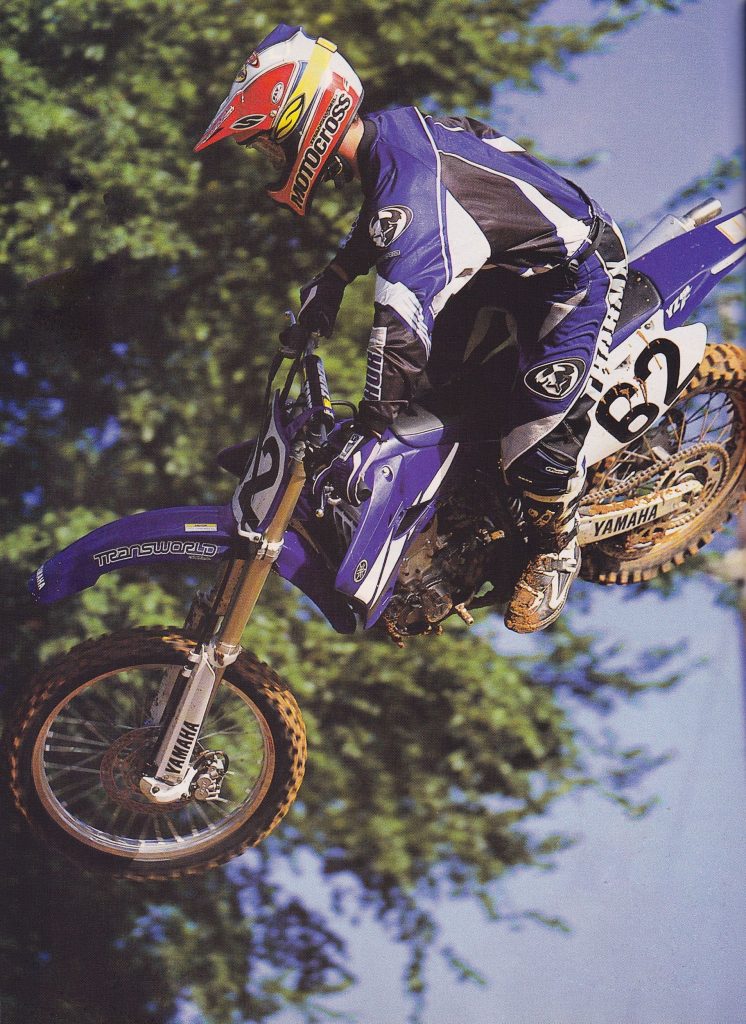 The 185 changes Yamaha made to the YZ-F in 2003 added up to a claimed 13.5-pound weight savings over the year before. This earned it the distinction of being the lightest machine in the class, but its big power and large feel fooled many into thinking it was the heaviest. Photo Credit: Transworld Motocross
The 185 changes Yamaha made to the YZ-F in 2003 added up to a claimed 13.5-pound weight savings over the year before. This earned it the distinction of being the lightest machine in the class, but its big power and large feel fooled many into thinking it was the heaviest. Photo Credit: Transworld Motocross
In 2002, the power structure of the four-stroke class finally shifted with the introduction of Honda’s YZ-F competitor, the CRF450R. Employing the third generation of their innovative alloy chassis and featuring an all-new “Unicam” motor design, the CRF450 addressed many of the issues four-stroke holdouts had voiced about the original YZ-Fs. Lighter, sleeker, smoother, and far easier to start than the YZ426, the CRF offered two-stroke converts an even easier transition to life without premix. Nearly overnight, starting gates across the county were awash in red Unicam machines.
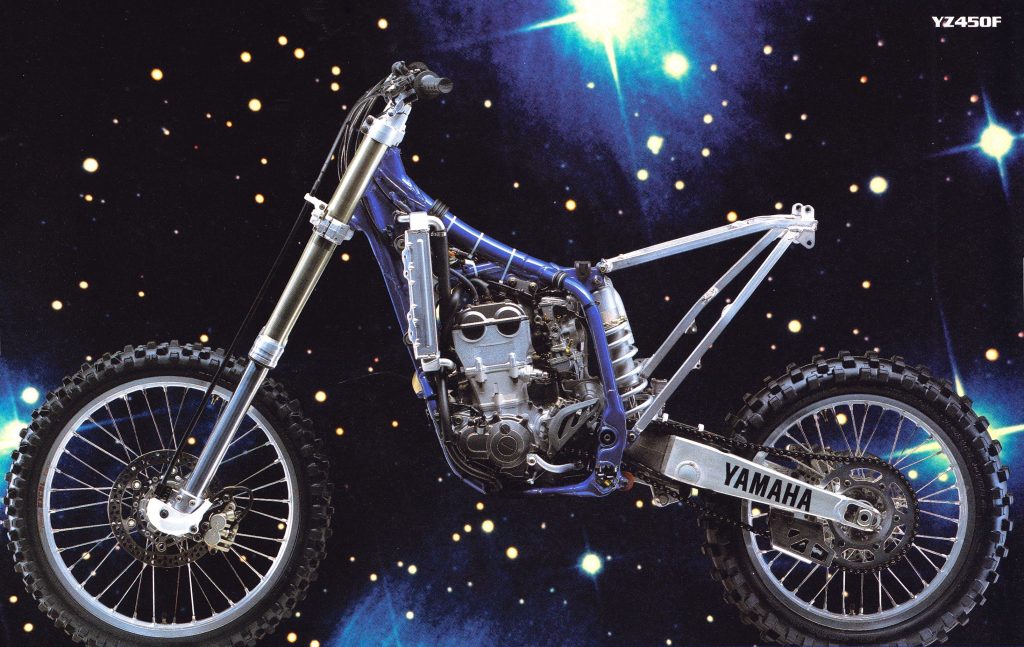 By sticking with steel for the frame’s construction Yamaha was able to design a machine with far easier access to most of the major components than on the CRF. Photo Credit: Yamaha
By sticking with steel for the frame’s construction Yamaha was able to design a machine with far easier access to most of the major components than on the CRF. Photo Credit: Yamaha
With the tremendous success of the CRF450R, it was pretty apparent that Yamaha would need to step up its game to recapture the top position in the four-stroke division. As competitive as the YZ426F was, its XR-like weight, stale looks, infuriating starting drill, and fondness for hesitation made it a tough sell when pitted against the easier-to-live-with Honda. Both machines were capable of winning, but most riders found the CRF to be the superior machine of the two.
 for 2003, Yamaha was able to ease maintenance by adding a secondary oil fill to the engine cases. Photo Credit: Yamaha
for 2003, Yamaha was able to ease maintenance by adding a secondary oil fill to the engine cases. Photo Credit: Yamaha
With so much profit and prestige at stake, Yamaha came ready to play in 2003. The original YZ-F platform was retired, and an all-new machine was introduced to do battle with Honda’s incredibly popular CRF. In all, Yamaha made 185 distinct changes in the transition from the YZ426F to the reimagined YZ450F. Weight saving was a major focus of the new design and Yamaha’s engineers looked at every component for a way to save a few precious ounces.
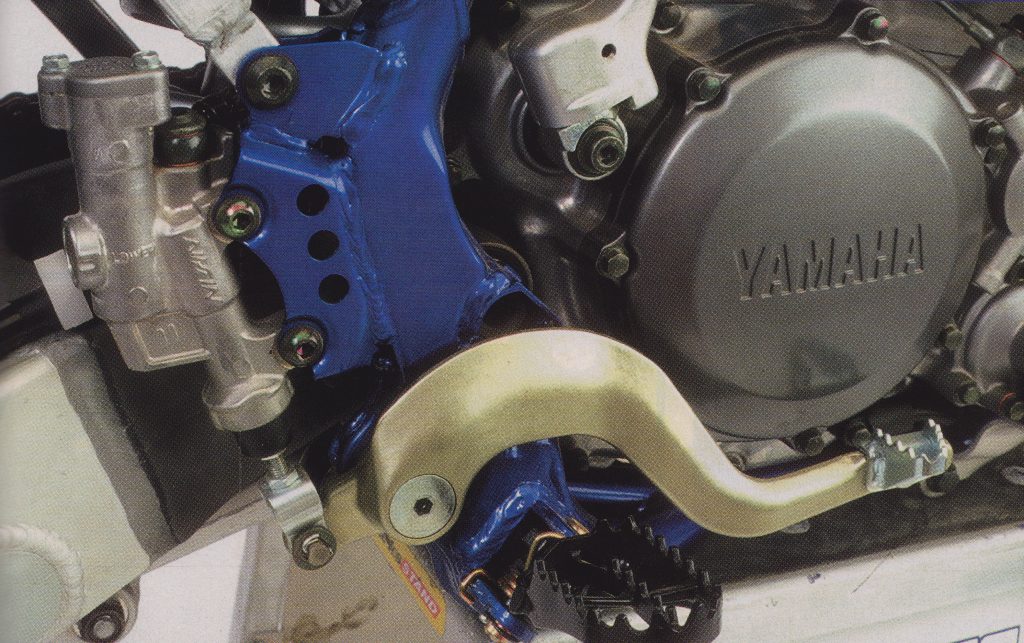 An all-new rear brake assembly reduced weight by shrinking the caliper size and integrating the master cylinder and fluid reservoir into one unit. Photo Credit: Motocross Action
An all-new rear brake assembly reduced weight by shrinking the caliper size and integrating the master cylinder and fluid reservoir into one unit. Photo Credit: Motocross Action
On the motor front, Yamaha retained the same basic DOHC layout and five-valve head it had used since 1998 but added 3.3mm of stroke to raise displacement to 449cc. An all-new cylinder shed weight by dropping two bolts from the cylinder base and the new head lowered the center of gravity by reducing its height by 7mm. The valves remained titanium in construction but were slightly shorter and 18% lighter than in 2002. Paired with the new valves were more compact springs and repositioned cams that allowed for a straighter valve angle within the head. A new automatic decompression system finally made its way to the valvetrain to simplify starting and bring it on par with the Honda and KTM.
 An all-new exhaust for 2003 shed pounds by moving to titanium for the head pipe, heat shield, and end cap. Photo Credit” Yamaha
An all-new exhaust for 2003 shed pounds by moving to titanium for the head pipe, heat shield, and end cap. Photo Credit” Yamaha
A new crankshaft assembly reduced weight by 20% and a 7% lighter piston was added to improve motor response. In a nod to Tim Ferry’s works machine, new cutouts were added to the cylinder skirt to reduce pumping pressure and further free up the top end. The cam-chain tensioner, oil pump, CDI, ignition coil, and flywheel were all reduced in size to lower weight and shrink the overall footprint of the motor. A new intake saved 12 ounces by redesigning the clamps to be internal. All the oil lines were moved from steel to aluminum as well to save a few additional ounces. In another nod to the works Yamaha machines the transmission was moved from a five-speed to a four-speed in 2003. Yamaha claimed the new transmission was both lighter and stronger than the old five-speed with new ratios designed to take advantage of the new motor’s additional torque. A new airbox shed 12 ounces and a redesigned exhaust swapped out steel for titanium in most of its major components.
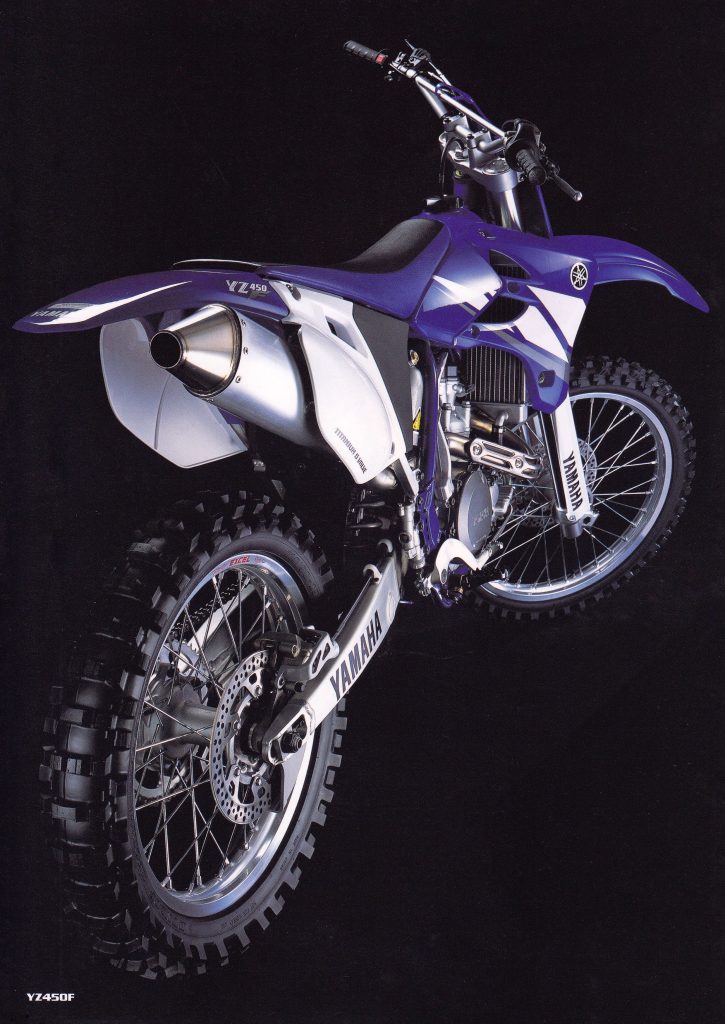 While US-bound YZ450Fs maintained the traditional end cap design of previous machines, bikes headed for other markets received an enclosed exhaust tip aimed at improving rider safety in a crash. Photo Credit: Yamaha
While US-bound YZ450Fs maintained the traditional end cap design of previous machines, bikes headed for other markets received an enclosed exhaust tip aimed at improving rider safety in a crash. Photo Credit: Yamaha
On the chassis front, the YZ450F was just as all-new and improved. The redesigned frame shaved three pounds off of 2002’s through the use of thinner cross tubing, a tapered steering head, and a smaller oil tank. A new rear brake lowered weight by adopting Honda’s integrated master cylinder and reducing the size of the caliper and piston. Up front, a new aluminum caliper piston improved feel and further shaved ounces. An all-new swingarm featured a tapered design and smaller axle blocks to save 80 grams. Even the chain slider was redesigned to save 25 grams.
 Former factory rider and 1991 San Jose Supercross winner Doug Dubach played a major role in the development of the all-new YZ450F. Photo Credit: Yamaha
Former factory rider and 1991 San Jose Supercross winner Doug Dubach played a major role in the development of the all-new YZ450F. Photo Credit: Yamaha
On the suspension side, a new shock saved 40 grams of weight and was paired with an eight-ounce lighter spring. The spring rate remained unchanged from 2002 but a higher grade of steel was used to reduce weight. Internally, the new shock was similar to 2002’s aside from the use of lighter-weight materials inside. Up front, the YZ450F retained the Kayaba bumper forks it had used in 2002 but added new valving, a redesigned damper rod, and new stanchions with less taper to improve feel.
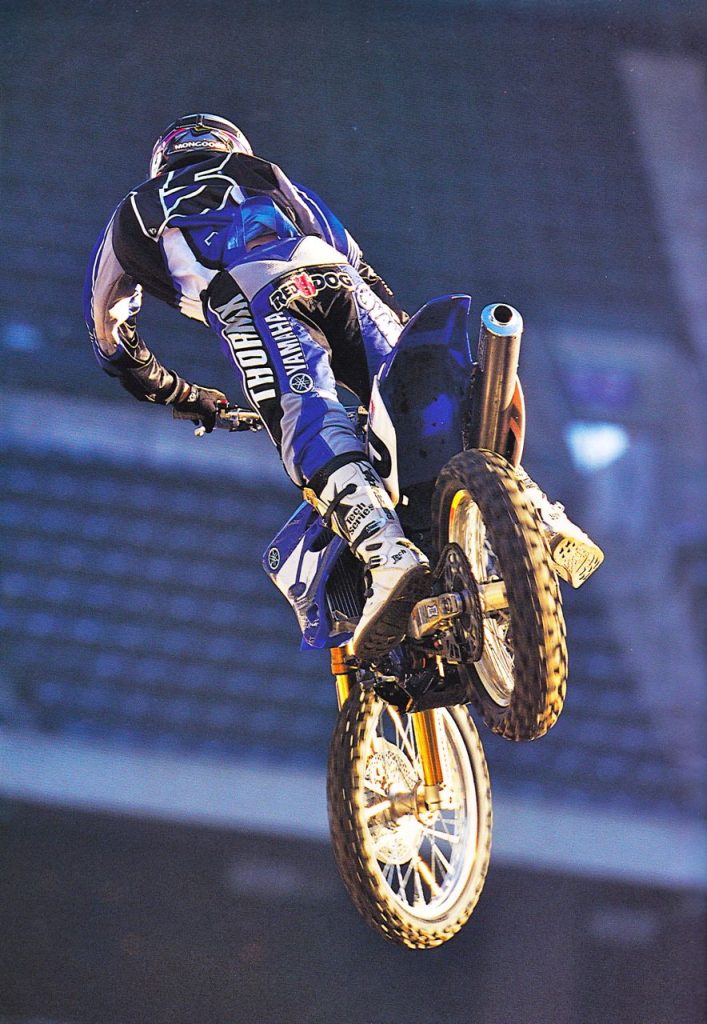 Timmy Ferry was Yamaha’s top gun on the YZ450F in 2003. Photo Pic: Simon Cudby
Timmy Ferry was Yamaha’s top gun on the YZ450F in 2003. Photo Pic: Simon Cudby
Visually, the biggest change for 2003 was the YZ450F’s all-new bodywork. This was the first major update of the YZ-F’s look since its 1998 debut and Yamaha took the opportunity to make major changes to its layout and feel. Everything from the fenders to the side plates was all-new with a lower, thinner, and flatter feel throughout. The new tank was narrower and less intrusive with a reduced capacity of 1.85 gallons from the previous 2.1 gallons. This allowed easier rider movement and saved 10 ounces. The seat was flatter through the middle and slimmer at the front making it easier to slide forward in turns. The new side plates remained very large and continued to incorporate handy cutouts to aid in lifting the machine when necessary. Altogether, the many changes Yamaha made to the YZ450F for 2003 added up to a claimed 13-pound weight savings over the 2002. When MXA weighed the two bikes full of fuel and ready to race the true number grew to 18 pounds! This was an incredible difference year-over-year and a testament to how much effort Yamaha put into trimming weight on the YZ-F. At a claimed 232 pounds, the new YZ450F undercut both the CRF450R and KTM 450SX in 2003 and leapfrogged the YZ-F from the portliest machine in the class to the most svelte of all the 450 offerings.
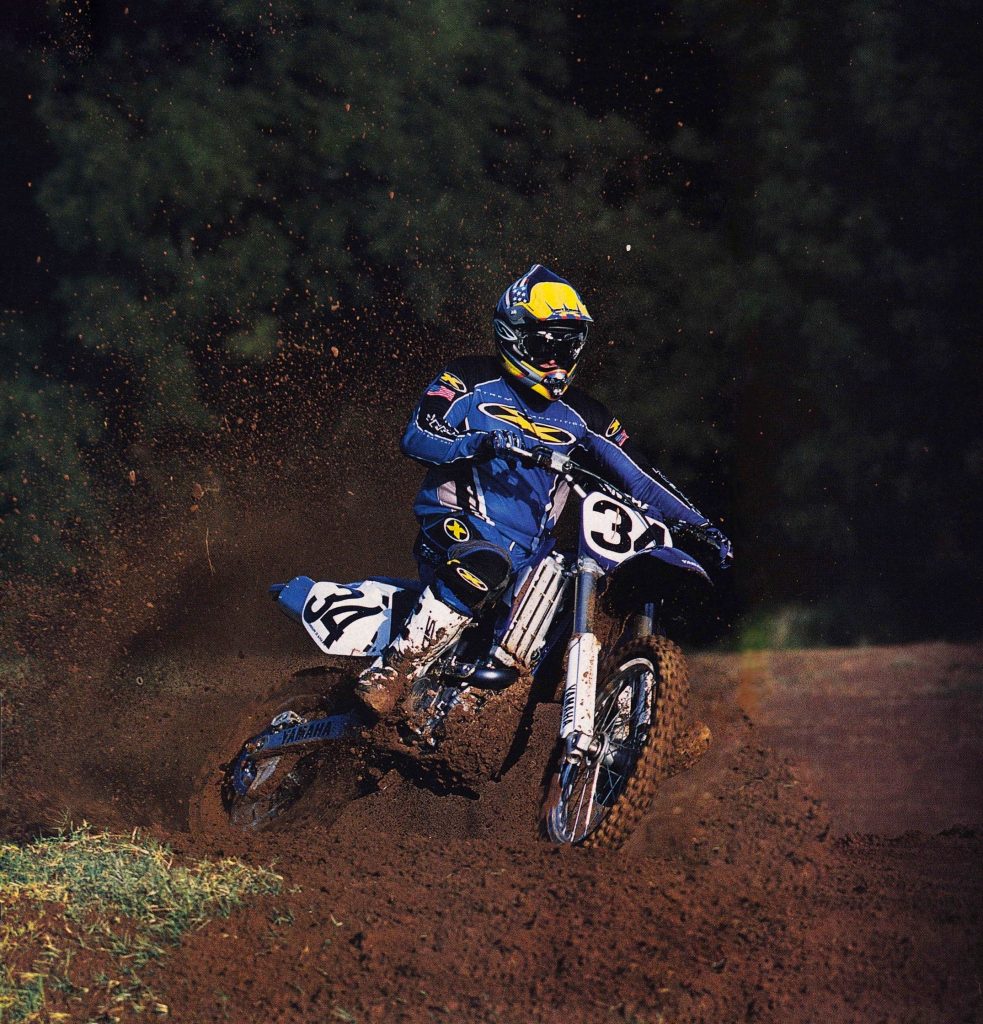
The new YZ450F was an excellent handler in 2003. Great turning and rock-solid stability made the machine a joy to shred on a freshly groomed track. It was only when the traction dried up that the bike became a bit of a handful. Photo Credit: Dirt Rider
On the track, all of these changes added up to a faster, leaner, and more serious machine. While the ’02 YZ426F was no slouch in the power department, it was no comparison to the fire-breather Yamaha produced in 2003. The new 449cc DOHC mill revved faster, hit harder, and pulled longer than ever before. It barked off the bottom, exploded in the midrange, and pulled till the cows came home on top. Unlike the CRF, which was smooth and pleasant, the YZ-F was all fire and brimstone. On the dyno, it pumped out three more horsepower than the Honda and every one of those ponies was apparent any time you twisted the throttle. It revved fast, hit hard, and demanded attention to keep things under control. The new motor did away with a lot of the “chug” of the YZ426 and not everyone was a fan of the change. The occasional low RPM stumble remained, but it was less-pronounced than on previous YZ-Fs. With the new motor, there was less compression braking once the throttle was closed but the engine was harder to control under power and a lot easier to stall. At least if you did stall it was no longer a nightmare to get relit. The new automatic decompression system did away with the elaborate starting drill of its predecessors and brought the Yamaha on par with its kick-and-go rivals.
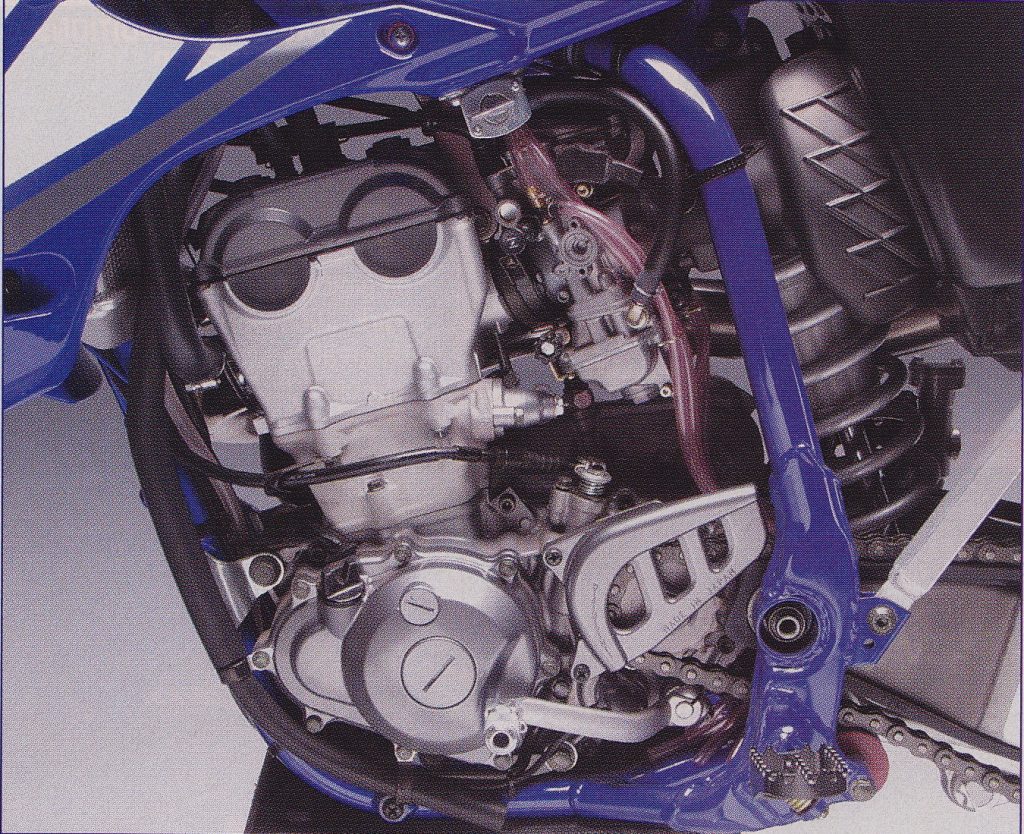
In 2003, this 449cc DOHC single was the master blaster of the four-stroke division. With a light flywheel, an explosive midrange hit, and gobs of top-end power, the YZ450F was an expert-level motor that was just too much for many to handle. Pros loved its pull, but mere mortals needed a heavier flywheel and a good bit of throttle discipline to keep its fury under control. Photo Credit: Motocross Action
Compared to a typical 250 two-stroke, the YZ450F offered excellent hookup, but when pitted against a KTM or Honda four-stroke, the YZ-F was a handful. Its hard hit and a fast spin-up made throttle control critical and the bike could be a lot for less experienced riders to handle. If there was deep soil and tons of traction the YZ450F was a dream with gobs of usable power on tap. If, however, the track was hard and slick, the Yamaha demanded more care with the throttle than its rivals to put all that power to the ground. With so much muscle on tap, most racers did not miss the additional gear in the transmission, but many felt the bike would have benefitted from a slightly heavier flywheel. Adding some weight to the flywheel smoothed out the explosive hit, aided hookup, and reduced stalling. With this addition, the fire-breathing YZ-F became a much more livable companion. While off-road riders were never going to love the four-speed transmission, with a heavier flywheel and some fine-tuning to the gearing it was not an issue for motocross.
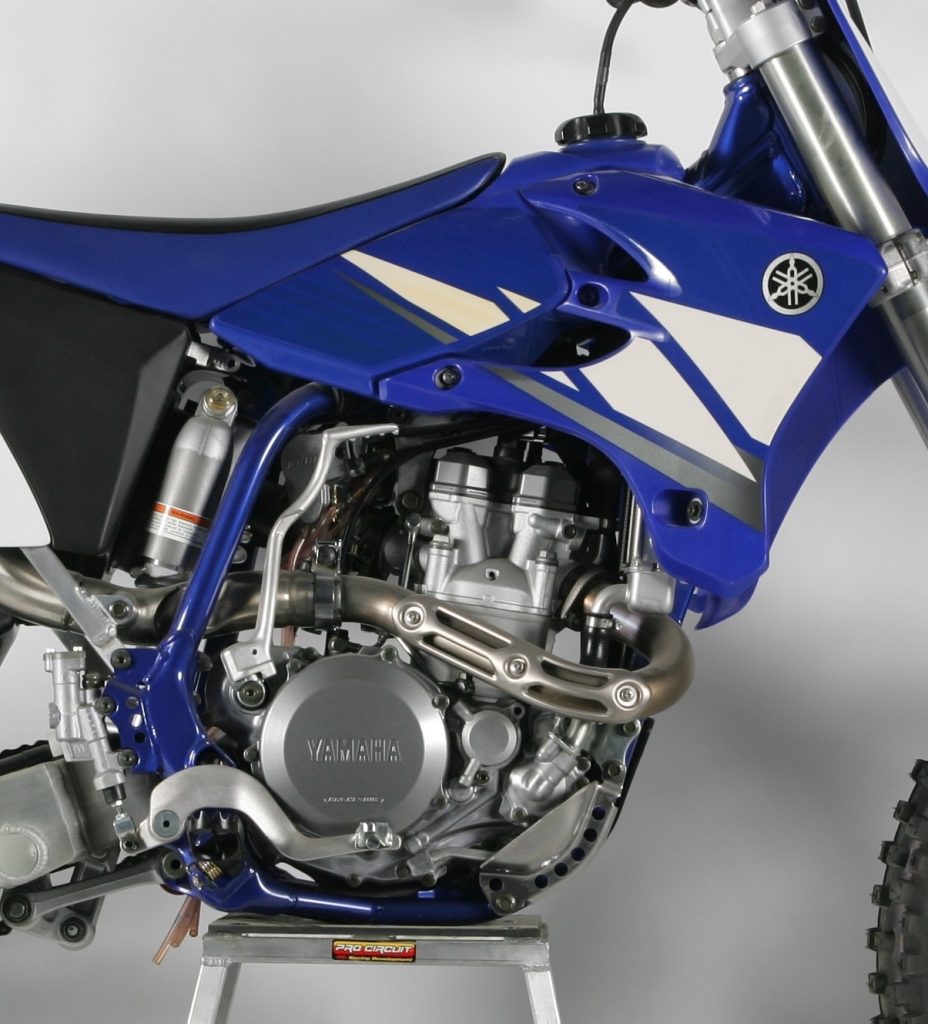 a new four-speed transmission saved weight but proved polarizing with the public. The lack of a fifth gear turned off casual riders and even some moto heads thought the gear spacing it provided was not ideal. Photo Credit: Stefan LeGrand
a new four-speed transmission saved weight but proved polarizing with the public. The lack of a fifth gear turned off casual riders and even some moto heads thought the gear spacing it provided was not ideal. Photo Credit: Stefan LeGrand
On the suspension front, the YZ was rated well in most categories. The new valving provided a slightly firmer feel and the bike was well-balanced overall. Up front, the Kayaba forks provided 11.8 inches of travel and external adjustments for compression and rebound damping. In stock condition, they were well-sorted and stiffer feeling than the CRF’s Showa components but still compliant enough to take the bite out of most track obstacles. Bottoming was not an issue and most riders below the pro class could get by without a revalve or spring swap. Lighter and slower riders found the plusher feel of the Honda components preferable but for serious racers, the YZ-F’s more aggressive forks settings were a good match.
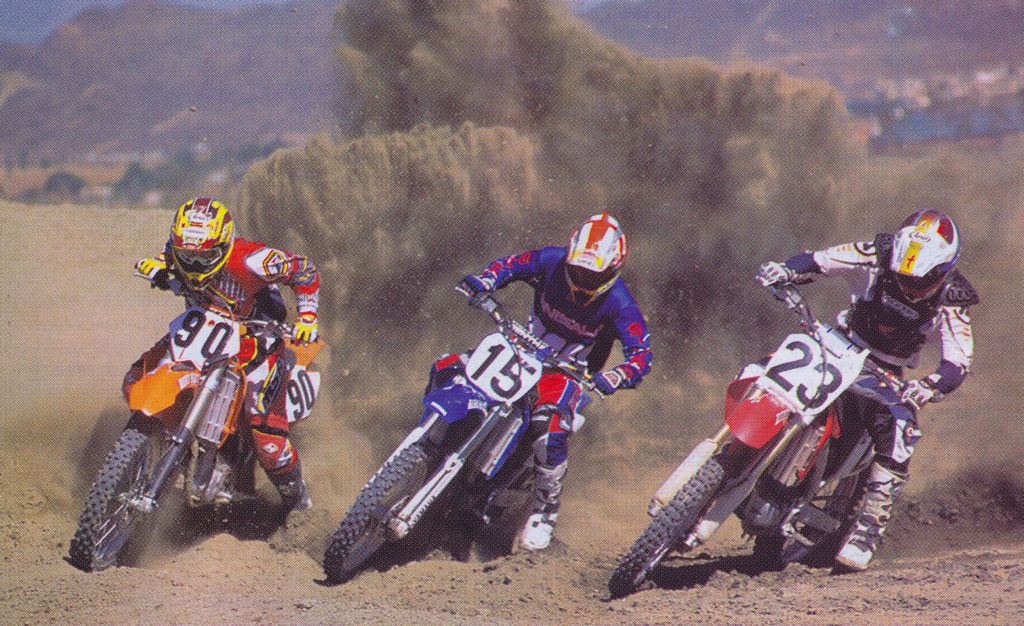 In 2003, there were three major contenders in the 450 division. The KTM offered high-quality components and a smooth engine but was hamstrung by a poor shock and four-speed transmission. The Yamaha featured the lightest weight and most horsepower but delivered it abruptly with the same four-speed issues that limited the KTM. For many, the Honda’s combination of easy-to-use power, five-speed versatility, good-enough handling, and supple suspension made it the bike to beat. Photo Credit: Dirt Bike
In 2003, there were three major contenders in the 450 division. The KTM offered high-quality components and a smooth engine but was hamstrung by a poor shock and four-speed transmission. The Yamaha featured the lightest weight and most horsepower but delivered it abruptly with the same four-speed issues that limited the KTM. For many, the Honda’s combination of easy-to-use power, five-speed versatility, good-enough handling, and supple suspension made it the bike to beat. Photo Credit: Dirt Bike
In the rear, the YZ-F was once again ranked at or near the top of the class. The stock shock settings were firm, and the rear delivered a well-controlled ride in most situations. It was reasonably compliant on small chop and excellent at dealing with big hits. This was a big improvement over previous YZ-Fs which often felt undersprung for their substantial weight. Just as with the forks, the KYB shock was not as plush as the stock CRF, but most fast guys preferred the firmer feel of the Yamaha. The new thinner seat did not provide a lot of cushioning, however, and more than a few riders complained of a sore backside after an afternoon on the YZ-F.
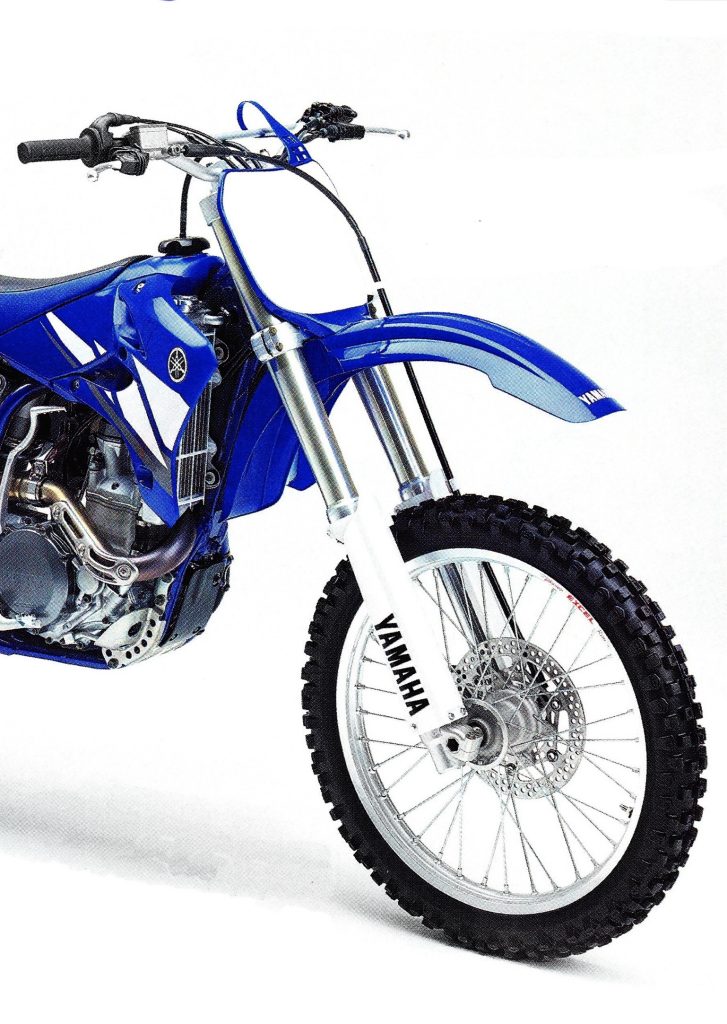 The 46mm Kayaba fork on the YZ450F delivered a firm but well-controlled ride that was perfect for attacking the track. Slower riders might have preferred the plusher settings found on the Honda, but for serious racers, it was an excellent fork. Photo Credit: Yamaha
The 46mm Kayaba fork on the YZ450F delivered a firm but well-controlled ride that was perfect for attacking the track. Slower riders might have preferred the plusher settings found on the Honda, but for serious racers, it was an excellent fork. Photo Credit: Yamaha
On the handling front, the YZ450F continued to be a great all-around machine. Turning precision was excellent with the combination of the motor’s strong compression braking, well-sorted suspension, and excellent chassis design providing an exceptional front-end feel. The new flatter seat and slimmer tank made it easier than ever to get forward in turns and the YZ-F could be trusted to hold its line without any fear of an unexpected washout. In most conditions, the YZ-F cornered like it was on rails and the bike was surprisingly adept at changing direction for such a big and powerful machine.
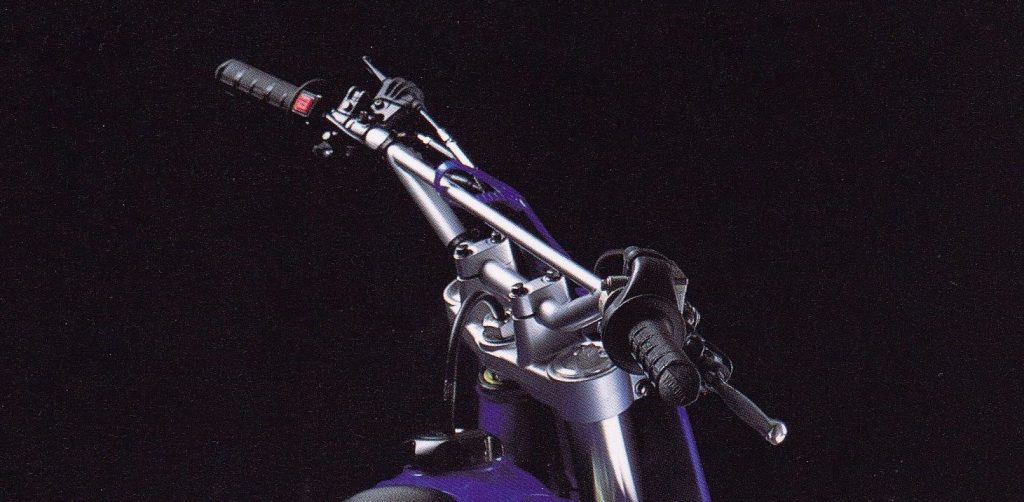 Steel bars were still standard equipment on Japanese machines in 2003. Photo Credit: Yamaha
Steel bars were still standard equipment on Japanese machines in 2003. Photo Credit: Yamaha
While the YZ-F’s front-end traction was exemplary, it could be a bit tricky to manage on the exit of turns if the track was hard and slick. In these conditions, the machine demanded respect and it was important to exercise restraint to prevent breaking the rear end loose. The YZ-F’s sudden delivery and monster hit made finding traction in these situations more of a challenge than on its competitors and the blue bruiser was known to hang its tail out suddenly if the pilot was ham-fisted with the throttle. The stock seat was also quite slippery, and many riders thought the YZ-F could have used a more grippy seat cover. Without it, it was a constant battle to keep your weight forward as the Yamaha’s megatons of thrust tried to pull you off the back. Much like an old-school 500 two-stroke, keeping the Why-Zed a gear high and being smooth with the throttle were the best techniques to keep the sometimes-unruly machine in line.
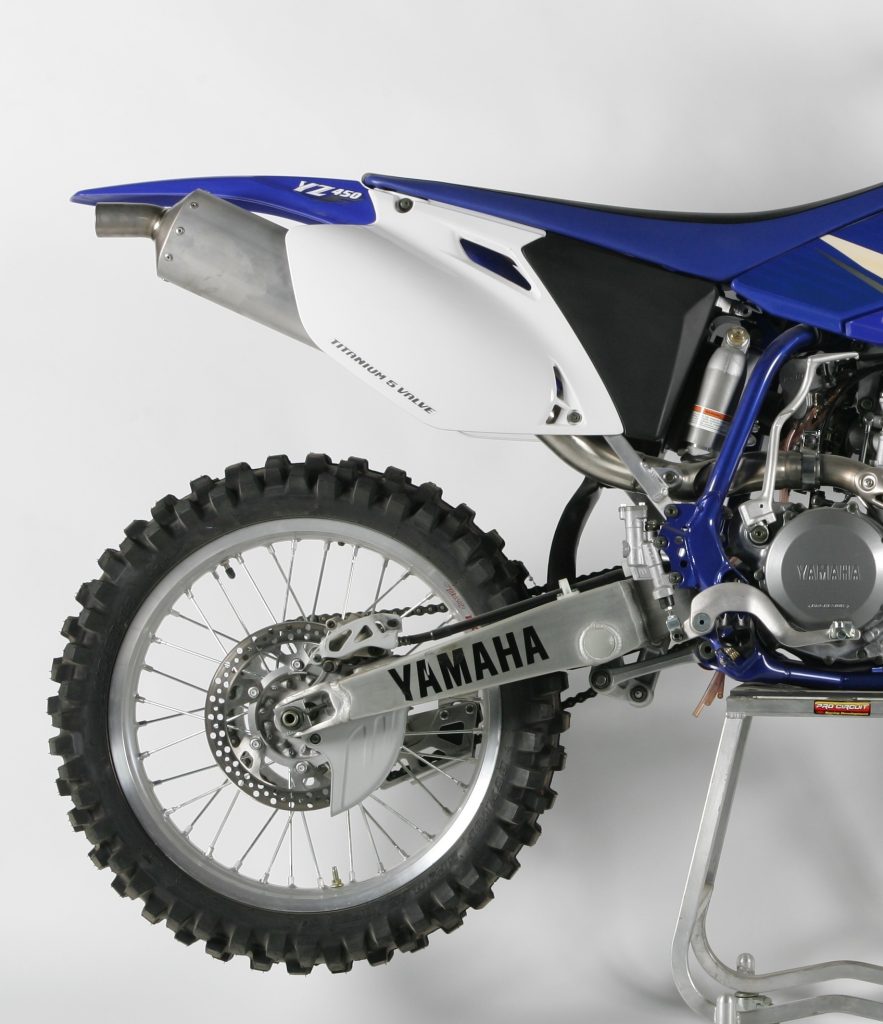 The rear suspension on the YZ450F was one of the best setups on the track in 2003. Its combination of compliance and control allowed the Yamaha’s pilot to pin it through the rough without any fear of a sudden kick or swap. Photo Credit: Stefan LeGrand
The rear suspension on the YZ450F was one of the best setups on the track in 2003. Its combination of compliance and control allowed the Yamaha’s pilot to pin it through the rough without any fear of a sudden kick or swap. Photo Credit: Stefan LeGrand
At speed, the YZ-F was in its element and the bike was excellent at gobbling up big swaths of track in a hurry. Even without a fifth gear, the YZ-F was capable of quasar speeds and the bike was a bullet train when it built up a head of steam. There was not even a hint of headshake and nothing short of an act of God was likely to knock the Yamaha off its intended path. Interestingly, even though the Yamaha was substantially lighter than before, it did not feel as light as the scale proclaimed it to be. Despite its 232-pound weight, it felt heftier than the 235-pound CRF and KTM on the track. It was a substantial improvement over the old YZ426F, but riders were never going to mistake the big and powerful YZ450F for anything but the Open bike that it was.
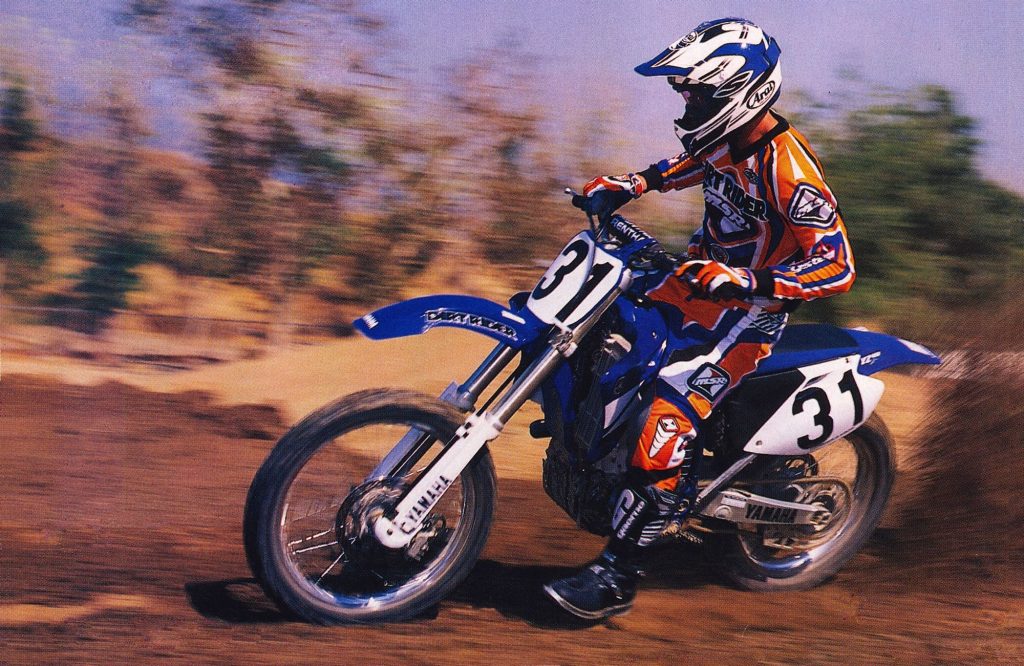 High-speed sweepers were a piece of cake on the YZ450F as long as you did not get too carried away with the loud handle on the exit. Here PulpMX’s own Kris Keefer puts all those luscious vibes to the ground for Bryan Nylander’s camera. Photo Credit: Dirt Rider
High-speed sweepers were a piece of cake on the YZ450F as long as you did not get too carried away with the loud handle on the exit. Here PulpMX’s own Kris Keefer puts all those luscious vibes to the ground for Bryan Nylander’s camera. Photo Credit: Dirt Rider
On the detailing front, the YZ450F was excellent in most respects. In addition to being the powerhouse of the class, Yamaha’s five-valve DOHC motor proved to be by far the most reliable. Its small and light titanium valves required less maintenance than the Honda and the dry-sump motor’s additional oil capacity gave it a margin of error not found on the CRF. As long as you changed the oil and cleaned the air filter regularly, the YZ450F was as bulletproof as any racing machine had a right to be. Its air filter was also far easier to access than the one found on the CRF. Both, however, were disappointing when compared to the toolless access offered by the KTM. Off-road enthusiasts and more casual riders hated the four-speed transmission, but most racers did not find it a huge hindrance for motocross. Some riders did complain that it occasionally felt “between gears” but it shifted well and most of the gaps could be managed with gearing changes aimed at individual track situations. While the four-speed worked well enough, many pit pundits thought deleting the fifth gear was an odd choice by Yamaha. It greatly hindered the YZ450F’s appeal for anything other than track use and considering consumers often buy 450s for their versatility, the pound or so of weight savings it yielded seemed like a poor tradeoff to many.
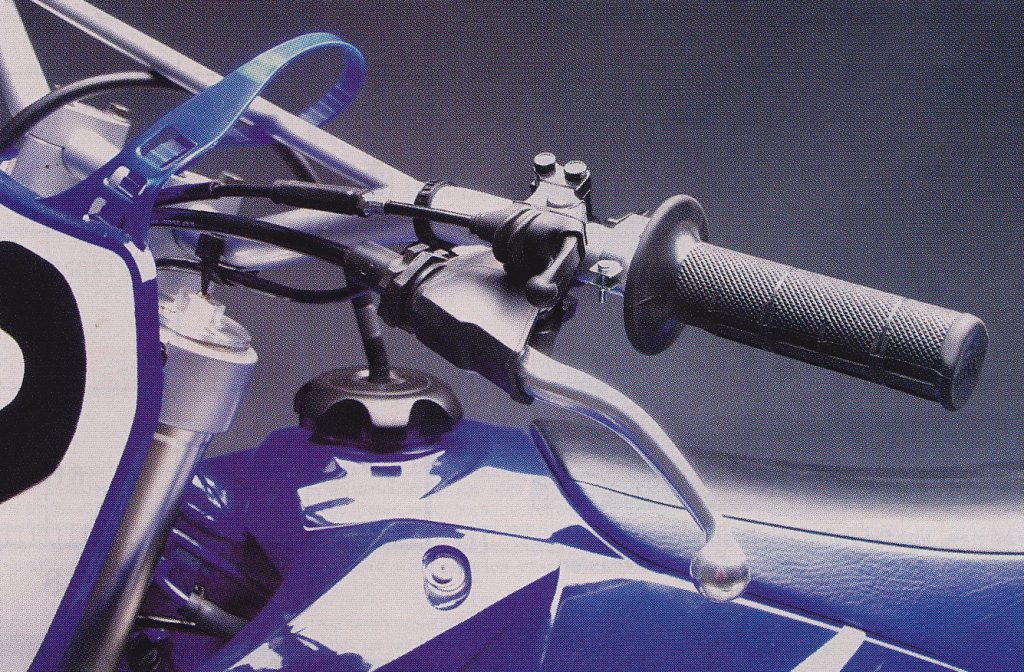 An all-new carburetor for 2003 moved the hot-start circuit to the handlebars for added convenience. Photo Credit: Motocross Action
An all-new carburetor for 2003 moved the hot-start circuit to the handlebars for added convenience. Photo Credit: Motocross Action
While not as trick-looking as the Honda’s aluminum frame, the Yamaha’s steel frame construction did have its advantages. Without the Honda’s massive aluminum spars, access to the motor and carburetor was much improved. The bike was also slightly thinner through the middle without the frame getting in the way. Cosmetically, all three 450s were handsome when new, but the painted frame, dark blue plastic, and flimsy graphics of the Yamaha tended to show their age far quicker than the competition. The powder-coated frame of the KTM and the bare aluminum chassis of the CRF looked new longer and both offered graphics that proved more robust under hard use. The butter-soft steel bars, flimsy stock sprockets, and stretch-prone chain were all de rigueur for Japanese bikes of the time and all three paled in comparison to the higher-quality components found on the KTM. The YZ-F continued to use a rather convoluted front brake routing (due to Honda patents) but its performance was excellent. The brakes were powerful front and rear and the new integrated rear master cylinder seemed to avoid the overheating issues that plagued the Honda’s move to this system. With its powerful brakes and tons of compression braking, the YZ-F was a hard machine to out-brake despite its large size.
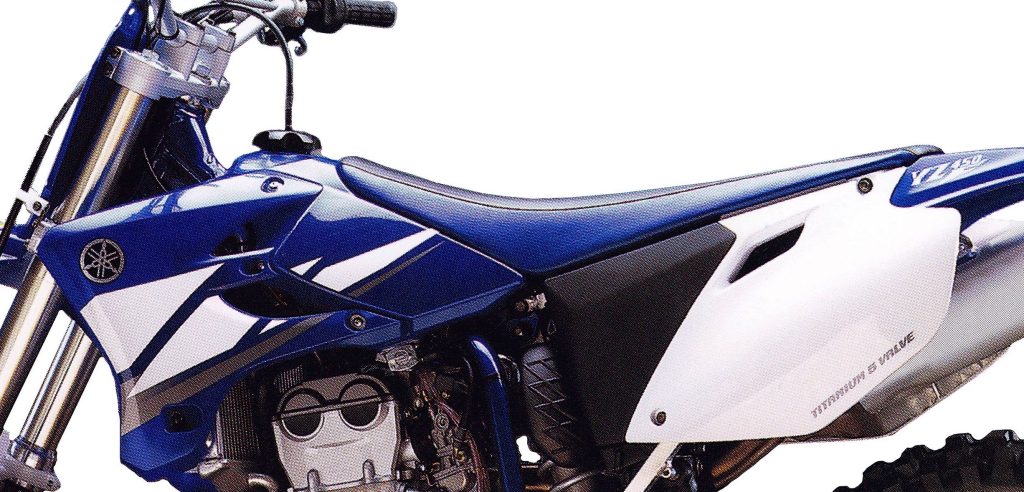 A redesigned pilot’s compartment for 2003 offered a flatter seat and slimmer profile. While the new seat made it easier to slide fore and aft, its thin foam and hard feel offended many a backside. Photo Credit: Yamaha
A redesigned pilot’s compartment for 2003 offered a flatter seat and slimmer profile. While the new seat made it easier to slide fore and aft, its thin foam and hard feel offended many a backside. Photo Credit: Yamaha
Overall ergonomics were praised with the new layout offering a flatter and slimmer feel that did away with the “pocket” that trapped some riders in place on the previous model. Some riders thought the seat-to-peg relationship was a bit cramped, but it fit most pilots very well. While the bike was easier to move around on for 2003, many riders were less enthusiastic about the new seat which was noticeably less comfortable than the old version. The redesigned seat featured foam that was very thin and firm with the plastic base being noticeable on hard landings. Both the KTM and Yamaha’s seats in 2003 were akin to sitting on slightly padded bricks and nearly everyone preferred the cushier Honda’s accommodations. The grips, levers, shifter, and running gear were all top-notch with a comfortable feel and smooth action. With the hot-start moved to the bars and its automatic compression release, the YZ-F moved from the hardest bike to start to one of the easiest. Typically, one good kick was all it took to get the big blue beast lit. After five years of starting drill misery, this was a TREMENDOUS improvement for anyone thinking of buying a YZ-F.
 In 2003, Yamaha built the lightest, fastest, stiffest, and most serious YZ-F yet, but not everyone was up to handling its Herculean nature. Photo credit: Stephan LeGrand
In 2003, Yamaha built the lightest, fastest, stiffest, and most serious YZ-F yet, but not everyone was up to handling its Herculean nature. Photo credit: Stephan LeGrand
Overall, the new Yamaha YZ450F turned out to be a bit of a polarizing machine in 2003. With its well-sorted suspension, excellent handling, rocket-fast motor, and lighter weight it was just the machine many riders had been longing for the blue team to produce. Easy to start, well put together, and stone reliable, the YZ-F had a lot to offer, but it required a lot in return. Not a machine for putting around or playing, the YZ450F was a brutish bike built to win on the track at the expense of everything else. Hard, stiff, fast, and razor-focused, the YZ450F was a hairy-chested beast of a machine that demanded respect but delivered performance by the megaton.
For your daily dose of classic moto, you can follow me @tonyblazier on Twitter and Instagram.


